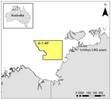 |
|
The Inez H. Eymard lift boat. Photo from Nick Welz, Tetra Tech Inc. |
Dominion Virginia Power is using L/B Inez H. Eymard for geotechnical site work this summer.
Throughout July, crews aboard the 110-ft. long liftboat acquired core samples for a proposed wind turbine construction project 27 miles off the Virginia coast. The crew also obtained core samples off the Virginia National Guard’s Camp Pendleton, where distribution lines serving the project will come ashore.
Dominion required geotechnical borings in a wide, near shore swath, ranging 300 to 3300ft from the shoreline, and used different vessels, depending on water depth. A hydroacoustic monitoring buoy is also deployed.
The 100ft-long utility boat Megan T. Miller, owned by Miller Marine Services, is conducting piezocone penetration tests along the cable route.
The Megan T. Miller has a 4-point anchor system, an articulating A-frame on the stern to manipulate survey equipment, and a knuckle crane aft.
A smaller vessel, the Moreen Yvette, was considered for near-shore geophysical surveying operations, but ultimately not used.
L/B Inez H. Eymard
The US-flagged vessel is an offshore construction jackup built in 2009 at the Marine Industrial Fabrication shipyard in New Iberia, Louisiana. The research vessel is owned and managed by Offshore Marine Contractors and is one of eight, 175-ft class liftboats in its fleet.
The self-propelled, self-elevating vessel planned to drill up to four geotechnical borings 27 miles offshore. The plan also included up to 11 near shore borings to evaluate the site proposed for the turbine foundations and distribution cable.
 |
|
The bridge of L/B Inez H. Eymard. Photo from Offshore Marine Contractors Inc. |
The vessel extends three, 175ft-long legs to the ocean floor to stabilize and raise itself. Each leg has 26ftx14ft pads to facilitate jacking up in soft soil conditions and minimize leg penetration. It can work in water to 130ft deep with 15ft air gap.
L/B Inez H. Eymard has approximately 4000sq ft of usable deck space and the aft deck has ample space to work and store equipment. The vessel’s moon pool allows drilling through the hull rather than using a cantilever over the side. Additionally, the main deck acts as a stable, non-floating platform in comparison to a standard vessel subject to the sea conditions.
The vessel is equipped with a 110 ton main crane and a 30 ton auxiliary crane. The main crane, with a 100ft lattice boom, has a dyform 34LR wire rope with a working strength of 39,280lb. The auxiliary crane, with a 70ft boom, has dyform 18-wire rope with working strength of 12,960lb.
Vessel positioning was accomplished with a wide-area differential global positioning system (DGPS) with Fugro StarFix satellite positioning system corrections. This primary navigation system uses survey-grade DGPS to correct raw satellite data. Differentially-corrected positions are passed to the onboard navigation computer running integrated navigational software. The DGPS corrections are supplied to the system using the Fugro STARFIX II.
Fugro used a skid-mounted, Failing 1500 offshore drilling rig for the borings using wet, rotary drilling methods. The drilling equipment included mud pump and mud mixing systems developed by Fugro for offshore geotechnical operations. Different types of drill bits and sampling systems were loaded aboard the vessel as well as a 5000lb laboratory testing cabin. The Failing 1500 offshore rig is 42ft long. and weighs 21,000lb. The diesel powered rig is operated by a six-person crew including two drillers and four helpers for continuous, 24-hr operation, 7 days/week.
Borehole drilling included soil sampling and downhole piezo-cone penetration tests (PCPT).
In clay soils, Fugro was instructed to take 5m samples along the borings. The cycle comprised 1 x 3m PCPT followed by 2x 1m samples. The objective is to achieve a recovery of at least 80% of the 1m-long samples.
Fugro planned to have a modified California clay sampler onboard the vessel; this sampling technique uses a split-barrel sampler to obtain undisturbed granular soil samples. Fugro also provided a thin-and thick-walled, wireline, 57mm percussion sampler, which allows for relatively undisturbed driven tube samples to be collected in granular, relatively dense soils, typically fine sands and cohesion-less silts.
 |
|
Inez H. Eymard -main deck plan view, profile view. From Offshore Marine Contractors. |
The geotechnical investigation was carried out as part of the Virginia Offshore Wind Technology Advancement Project, for which Dominion has secured grants totaling US$51 million from the Department of Energy. Pending the results of the investigation, Dominion plans to build two, 6Mw wind turbines on the proposed site and conduct tests on design features intended to lower the cost of construction, reduce maintenance and withstand hurricane-force winds.
Dominion also holds the lease on 112,800 acres of commercial wind area adjacent to the demonstration project. The company intends to use lessons learned from the turbines to guide the development of up to 2000Mw of wind turbine energy.
The two turbines would produce enough electricity to power 3000 homes. Dominion still needs to obtain several regulatory approvals. If approved by the Virginia State Corporation Commission and upon receipt of environmental permits, the turbines would be operational in 2017.
To develop the demonstration project, Dominion is working with a team of national and international organizations including, Alstom Power Inc., KBR, Commonwealth of Virginia Department of Mines, Minerals, and Energy, National Renewable Energy Laboratory, Virginia Tech Advanced Research Institute, Keystone Engineering, Newport News Shipbuilding, and Tetra Tech Inc.
 |



